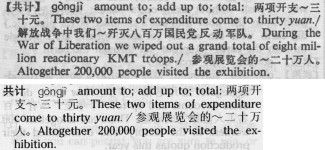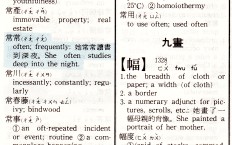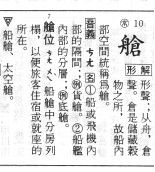
|
book review Chinese-English Dictionaries
|

|
book review Chinese-English Dictionaries
|
 dictionary is always a trade-off between size, completeness, and usability.
For Chinese, the reader must also decide whether they need complex
or simplified characters (or as we say in the States, original or extra
crispy characters), and which way of finding characters they prefer to use.
dictionary is always a trade-off between size, completeness, and usability.
For Chinese, the reader must also decide whether they need complex
or simplified characters (or as we say in the States, original or extra
crispy characters), and which way of finding characters they prefer to use.
The two common ways of finding characters in Mandarin Chinese are pinyin and zhuyin. Pinyin uses English letters (p, ch, j, z, etc.) for each phoneme. They're easy to type on a US keyboard, but their pronunciation is sometimes quite different from English. For example, 'c' is pronounced as /tsʰ/; 'x' is pronounced with an /hs/ sound (IPA ɕ). The other method, zhuyin, is exact, but is often resisted by students because it means memorizing the 37 zhuyinfuhao characters. Little do they realize that 37 is a small number compared to the task they face.
There are also political factors. Hanyu pinyin and simplified characters were created by the Communist Chinese government, while most things written elsewhere, and almost all the ancient Chinese literature, are printed in the regular “complex” characters. So the ideal dictionary would have both.
This table compares the dictionaries I am familiar with.
| Title | Pages | Size (inches) | Entries (× 1000) | Characters | Pinyin | Zhuyin | Simplified chars | Complex chars |
|---|---|---|---|---|---|---|---|---|
| A Chinese-English Dictionary (Han-Ying Cidian) | 1752 | 8×6 | 80 | 6,800 | Y | N | Y | Y |
| The Pinyin Chinese-English Dictionary (Han-Ying Cidian) | 976 | 9×6½ | 62 | 6,000 | Y | N | Y | N |
| Concise English-Chinese Chinese-English Dictionary | 600 | 6×3½ | 20 | 5,000 | Y | N | Y | Y |
| Guoyu Huoyong Cidian | 2150 | 8½×6½ | 13,961 | N | Y | N | Y | |
| Far East Chinese-English Dictionary, Concise Ed. | 1873 | 6×4½ | 120 | 7,331 | Y | Y | Y | Y |
| A New English-Chinese Dictionary | 1689 | 8×5¼ | 80 | NA | N | N | Y | N |
| Cantonese Dictionary | 483 | 10×7¼ | 20 | 1,200 | N | N | N | Y |

These two are probably the most popular full-size Chinese dictionaries out there, and they're almost identical to each other. A Chinese-English Dictionary is an expanded version of The Pinyin Chinese-English Dictionary. It has some longer definitions and a few more characters, and it gives the complex and variant forms for the characters instead of just the simplified form used in mainland China. For example, the entry for xue (study) is “学(學, 斈)” in C-E but only “学” in Pinyin.
 Usage examples for gongji in Pinyin and A C-E Dictionary (Revised edition).
The major difference is that in Pinyin, many of the examples are
Communist propaganda slogans.
These slogans give the dictionary a Cold War
Mao Tse-Tung Communist dictator ambiance which is sometimes chilling.
Examples: “The broad masses of people and armymen fought staunchly
with one heart and one mind to defeat the aggressors.”
“By their very nature imperialism and social-imperialism mean war.”
“During the War of Liberation we wiped out a total of eight million
reactionary KMT troops.”
Usage examples for gongji in Pinyin and A C-E Dictionary (Revised edition).
The major difference is that in Pinyin, many of the examples are
Communist propaganda slogans.
These slogans give the dictionary a Cold War
Mao Tse-Tung Communist dictator ambiance which is sometimes chilling.
Examples: “The broad masses of people and armymen fought staunchly
with one heart and one mind to defeat the aggressors.”
“By their very nature imperialism and social-imperialism mean war.”
“During the War of Liberation we wiped out a total of eight million
reactionary KMT troops.”
Here are some more examples:
bu chi = not less than
The people longed for the coming of the people's liberation army as one
longs for rain during a drought.
bu guan = no matter what
Under the leadership of the party, we can overcome any difficulty, however great.
No matter how busy we are, we always find time to study Chairman Mao's works.
In the C-E “Revised” Edition most of these totalitarian usage examples have been replaced with stuff straight out of Renmin Ribao, which is probably the dullest newspaper of all time. Dead prose is their specialty. So in C-E, the usage example for guanyu (“with regard to”) is: “We are preparing to hold a meeting in which we will look into problems regarding the quality of education.”
Most people think communism collapsed because it was economically uncompetitive or because they massacred too many of their own people. I suspect the real reason was that life in a Marxist state is insufferably boring. A typical lead story in Renmin Ribao would be about some provincial dam the government was building: how many cubic meters of dirt were being removed ... how many hectares the lake would cover ... how many metric tons of rock ... how many truckloads of dirt. People can only take so much of that.
In both dictionaries, characters are ordered alphabetically by their pinyin and tone. Finding a word here is a multi-step process:
This is very time-consuming and provides a strong incentive not to forget how a character is pronounced.
The main characters are only a little bigger than the word entries, which makes it easy to miss characters.

 Section of Far East English-Chinese Dictionary showing
a highlighted definition.
Section of Far East English-Chinese Dictionary showing
a highlighted definition.
Despite its small size, this is an outstanding dictionary. In addition to the multi-step radical index method, there is another index that has the characters indexed strictly by stroke number. Then in the back there is a zhuyin index, a pinyin index, and a third index which uses a quirky, complex pronunciation scheme called Gwoyeu Romatzyh, which encodes the four Mandarin tones into the spelling instead of using diacritical marks. Characters are organized by radical and stroke count, not pronunciation.
The characters are dark and easy to find, and each word or phrase has the pronunciation in zhuyinfuhao next to it. The characters have pronunciation in zhuyin, pinyin, and Gwoyeu Romatzyh. The more common words and their definitions are highlighted in pink, green, or blue.
The pages are really thin: 0.04 millimeters. Make sure you learn the zhuyin pronunciation code before trying to use this one. Cover is bright red plastic.

This is a small travel dictionary, not very useful for experts, but great for beginners. In the English-Chinese section, pinyin pronunciation is given for the Chinese definitions and IPA pronunciation is given for the English entries. The definitions use simplified characters with regular characters in parentheses. The definitions, as the title suggests, are very concise; there are very few example sentences.
In the Chinese-English section, characters are ordered alphabetically by their pinyin Romanization as usual. Both regular and extra-crispy characters are given for the character entries, but only for some of the words. Uses a Radical Index and Stroke Index system like Han-Ying Cidian (above). Pinyin pronunciation and part of speech of each word are given. Has a red plastic cover.

 Section of Guoyu Huoyong Cidian for cang
(“cabin in a boat or plane”).
Section of Guoyu Huoyong Cidian for cang
(“cabin in a boat or plane”).
This one is very popular in Taiwan. There is not a single English word in this book, so technically it's not a Chinese-English dictionary, but it's a great dictionary and has a great indexing system. Characters are ordered by radical and number of strokes. Pronunciation is given for each word in zhuyinfuhao only—no pinyin and no simplified characters at all. The old-style Small Seal script characters are also shown.
There are three ways of finding a character. The fastest is to use the radical index on the inside cover, which gives you the approximate page, and then page around by number of strokes. This makes it faster, especially if you don't know the pronunciation of a character. There is also a character index listed by stroke number, a big table of variant characters, and a zhuyinfuhao index, so you can look up the character by pronunciation.
Page sequence is the traditional back to front, vertical, and right to left. Best Chinese dictionary I own. But watch out—I dragged my copy all the way across the Pacific only to find a bunch of pages missing in the middle. Brown plastic faux leather flexible cover and 2,150 very thin pages.

 A New English-Chinese Dictionary
English-Chinese only dictionaries are very popular in China, but are often
useful for English speakers as well. For instance, if you wanted to know how
to write “state of the art” in Chinese, this dictionary would be
ideal, because it has Chinese equivalents for this and many other idiomatic
English expressions. It's far superior to Google Translate, which is too
inaccurate for serious work. This dictionary was created by
a number of universities in mainland China. It's indexed alphabetically and
uses simplified characters only. The lack of pinyin pronunciation in the
definitions means it's not for beginners.
A New English-Chinese Dictionary
English-Chinese only dictionaries are very popular in China, but are often
useful for English speakers as well. For instance, if you wanted to know how
to write “state of the art” in Chinese, this dictionary would be
ideal, because it has Chinese equivalents for this and many other idiomatic
English expressions. It's far superior to Google Translate, which is too
inaccurate for serious work. This dictionary was created by
a number of universities in mainland China. It's indexed alphabetically and
uses simplified characters only. The lack of pinyin pronunciation in the
definitions means it's not for beginners.

A lot of Cantonese learning stuff comes from Yale, including this English-Cantonese / Cantonese-English dictionary. The English-Cantonese section is all Yale Romanization, which uses a combination of diacritical marks and final 'h' to distinguish the seven Cantonese tones. There are no Chinese Characters at all in this section—only pronunciation.
The Cantonese-English section is minimalistic, with hand-drawn complex-style characters. Indexing is alphabetic by Yale Romanization of the complete word—none of this fancy character and stroke stuff.
This dictionary was published in 1970; dictionaries of any of the dialects are hard to come by. Students usually learn Mandarin first, then branch out into the other dialects, so books like this are not intended for translation. They're considered dialect learning tools, which is why there are only about 1200 characters here.
You might think there's not much need to learn regional dialects like Cantonese, Minnan, or Hakka. But if you visit Asia you will discover a very unusual fact: if they find out you can speak Mandarin they immediately switch to their local dialect and start talking about you. There's only one way to know what they're saying, and that's to learn a bunch more stuff—and not tell them.
Reviewed on this page:
Chinese-English Dictionaries

sep 24, 2014; updated jan 05, 2015
other book reviews
to top